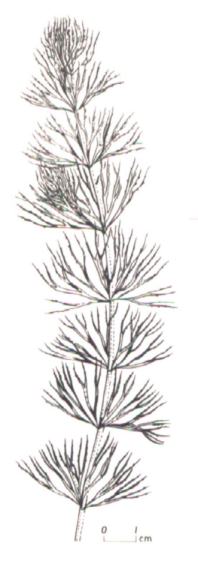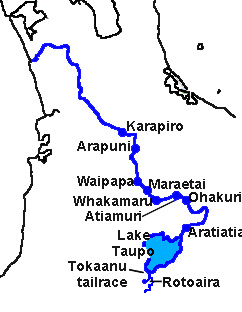The End of an Invasion

Hornwort - The End
of an Invasion

|
The
noxious weed hornwort (Ceratophyllum demersum) has finally invaded
the Waikato River from the most upstream headwater lake in the south, Lake
Rotoaira, to the river mouth in the north. This invasion has taken just
over 35 years. Hornwort (Ceratophyllum demersum) was first discovered in the Waikato catchment, in1963. It was found in Lake Ohakuri, one of eight hydrolakes lying between Lake Taupo and the sea. Recently (February 1999), hornwort was found in the weed mass removed from the Tokaanu hydroelectric station’s intake screen at the northern end of Lake Rotoaira. Quantities of hornwort were also seen floating beside the weed boom and growing amongst the oxygen weed (Lagarosiphon major) along the shore. This
lake had previously been free of this weed. |
Hornwort
invasion of the Waikato catchment has followed both expected and
unexpected patterns. From Lake Ohakuri, hornwort rapidly spread
downstream. By 1966 it was
established in the three hydroelectric lakes immediately downstream of
Ohakuri (Atiamuri, Whakamaru and Maraetai), and 5 years later it had
reached the remaining downstream hydroelectric impoundments and,
downstream of these, was found in the main river channel to the river’s
mouth.
Hornwort does not have roots and is readily transported by water currents. It is not just found at the surface. A study using nets set at different depths in Lake Atiamuri found hornwort drifting with the current from the surface to at least 25 m depth (the depth of the deepest net), and underwater video has revealed hornwort caught on the screens of the penstock intakes at Maraetai hydroelectric station, which are 40 m below the lake’s surface. The downstream colonization by this weed is, therefore, no surprise, because even deep water intakes are no real barrier to its downstream dispersal.
Invasion
upstream or to another catchment is, however, another matter.
Evidence strongly suggests that dispersal upstream normally happens
by weed fragments either on boats that are transported between lakes, on
fishing nets used in more than one lake, or in aquarium releases, rather
than by natural means such as on waterfowl.
A
comprehensive aquatic weed survey of the Waikato River system in 1975
found that hornwort was not present in the lakes upstream of Lake Ohakuri
(Aratiatia, Taupo and Rotoaira respectively).
A similar survey in 1980 found that although Aratiatia and Rotoaira
were still free of hornwort, it was present in the Tokaanu hydroelectric
power station tailrace and Waihi Bay at the very southern end of
Lake Taupo.
 The
presence of hornwort at this southernmost part of the lake was somewhat
surprising, as the nearest source was about 75 km downstream.
Local residents provided a possible explanation. In 1976 or early
1977 an experimental NZED weed harvester was brought from Lake Ohakuri to
the Tokaanu tailrace to test harvest the oxygen weed Lagarosiphon.
Locals observed that when the harvester was launched, it was carrying
quantities of hornwort. Photographs
of the exercise were taken too far from the harvester to determine whether
this is how hornwort hitched a ride to the south end of Lake Taupo.
However, no other plausible explanations have been suggested for
this significant upstream movement.
The
presence of hornwort at this southernmost part of the lake was somewhat
surprising, as the nearest source was about 75 km downstream.
Local residents provided a possible explanation. In 1976 or early
1977 an experimental NZED weed harvester was brought from Lake Ohakuri to
the Tokaanu tailrace to test harvest the oxygen weed Lagarosiphon.
Locals observed that when the harvester was launched, it was carrying
quantities of hornwort. Photographs
of the exercise were taken too far from the harvester to determine whether
this is how hornwort hitched a ride to the south end of Lake Taupo.
However, no other plausible explanations have been suggested for
this significant upstream movement.
Prevailing
winds over Lake Taupo are from south to north, so it was only a matter of
time until hornwort began to drift north, leave Lake Taupo and invade Lake
Aratiatia via the Waikato River. In
June 1983 hornwort was found in the two major backwaters of Lake
Aratiatia. It is not
surprising that this is where the weed first appeared. Studies had just
been done to determine if much of the aquatic weed accumulating on the
Aratiatia power station penstock intake screens could be coming from Lake
Taupo. The studies
showed that this was not the case and that most weed from Taupo ended up
in the backwaters of Aratiatia, exactly where hornwort first established
itself. In addition, neither of these areas is near a boat ramp or
easily accessible by land, so the hornwort invasion of Lake Aratiatia
appears to have been simply by natural means.
In
contrast, annual inspections of weed removed from the intake screens at
lake Rotoaira, upstream of Lake Taupo, found no hornwort until 1999.
Thus, assuming it takes a year or two from introduction to becoming
a noticeable component of the lake’s flora, it took over 20 years for
hornwort to travel the approximately nine kilometers from the southern end
of Lake Taupo to Lake Rotoaira. It is likely that the weed entered the
lake through someone’s carelessness, not cleaning their boat or fishing
nets of weed before using the lake.
In
terms of “the ride”, Rotoaira is the end of the line for hornwort in
the Waikato river system.
The only lake left is Rotopounamu, Although this land-locked lake, perched high on Mt Pihanga between Taupo and Rotoaira, does not have hornwort, it is unlikely to be successfully invaded. Rotopounamu is extremely unusual in that it has virtually zero alkalinity. Thus, it is one of the few lakes in New Zealand that is not conducive to the growth of hornwort – even if that weed could climb mountains!
Contact:
Ian Johnstone, Chisholm Associates,
PO Box 12443, Chartwell, HAMILTON,
Email: ipca@xtra.co.nz
Added August 1999